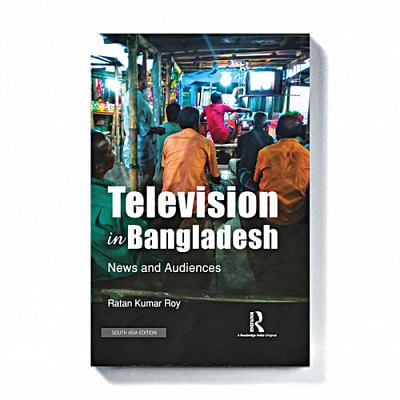A new book explores the mediascape of Bangladesh

We barely see cross-disciplinary initiatives that try to understand our media, culture, society and politics. In this wake, Dr Ratan Kumar Roy's Television in Bangladesh: News and Audiences (Routledge, 2021) offers a rich ethnography of television news practices in Bangladesh, with a foreword by Marcus Banks, Professor of Visual Anthropology at Oxford University.
Dr Roy has been trained in anthropology and sociology from the University of Dhaka and the South Asian University, New Delhi. He formerly worked as a broadcast journalist in Bangladesh and is currently working as a fellow at the Jamia Millia Islamia University (New Delhi). In this latest work, he draws a synoptic history of television media, public engagement, and politics in Bangladesh, and shows how political regimes and public participation have contributed to the development of television media culture.
"[H]istorical analysis reveal[s] that television has neither been an innocent medium nor are its viewers helpless consumers or morbid subjects on the receiving end", Roy writes. He addresses how the emergence of 24/7 news channels in Bangladesh contributed to the formation of a localised public sphere, wherein tea stalls, paan shops, rickshaw stands, clubs, and small restaurants became locations for debate and discussion over current affairs. These audiences can read and consciously engage with televised news and the media practices of news professionals.
On that note, Roy invites readers to delve deeper into the workings of news media in contemporary Bangladesh beyond the parameters of state-control, democracy, freedom of expression, hegemony, and political biases. As a possible alternative he shows how 24-hour news channels have sustained and contributed to the emergence of youth protests and social mobilisation in Bangladesh, how marginal localities engage with, connect with, and contradict popular representation by mainstream media. On the other hand, he highlights some underlying issues plaguing the news cycle—based on interview responses from journalists, news editors, and high ranking officials from the newsroom, Roy identifies the external forces that often regulate and control news culture. "[A]lmost every second day there is a phone call from these external bodies and at least once a month the key officials have to meet them in person", he writes.
Roy uses interviews and narratives to highlight the discomforts and challenges faced by media professionals. Journalist Tushar Abudullah, who was at the forefront of many news-based television channels in Bangladesh, tells Roy: "[T]he rape case of college student and cultural activist Tonu in Cumilla in 2016 was one such case where the viewers' demand enabled [us] to take up the issue".
"Our managing director himself is a journalist, he understands news values, but when he advises us to undermine some important news, then we understand it is due to [...] pressure from external bodies", Shumee Shahabuddin, a senior news editor at a 24-hour news channel, tells Roy in another interview.
Based on such empirical evidence, Dr Roy's book argues that television news practice in Bangladesh is ambiguously professional and commercial in character. It has not been able to become a mature and profitable business industry because it still surrenders to the whims of ownership, political ideologies, and biases. It also operates with values and ethics that are often contradictory to the logic of the market economy of media. This is why self-censorship has been a prevailing factor for news television, and this is why viewers are switching to digital media platforms.
Following such a shift in viewership, mainstream media has started exploring digital possibilities, such as incorporating special "web desks" and investing in social media outreach, the latter of which can sometimes be sensational. But the challenge of facing the Digital Security Act remains a vital concern.
Mostafa Shabuj is Bogura correspondent, The Daily Star, and a former student of Sociology at the South Asian University, New Delhi, India. Email: [email protected]

 For all latest news, follow The Daily Star's Google News channel.
For all latest news, follow The Daily Star's Google News channel. 



Comments